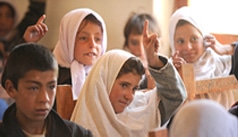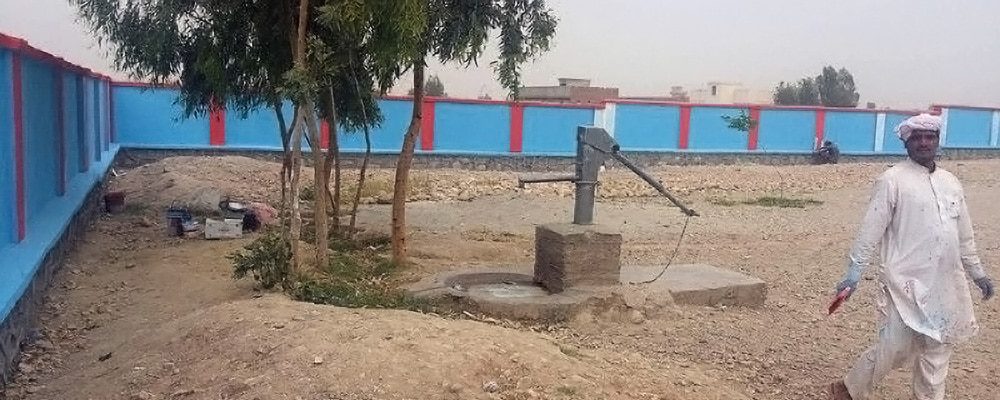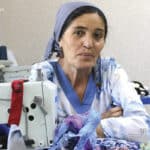Photo Update: New Construction to Keep Children Safe
For many in Central Asia, education takes place outdoors. Without classrooms or school buildings, students sit in chairs or on a carpet. If there is enough money, the school can buy a tent to keep rain and wind from stopping a lesson.
With little else to distinguish where a school property begins or ends, strangers can wander right onto the property or lurk at its borders. If that sounds concerning to you, it is as well for parents. Too often, that danger results in children kept at home, away from a threat of kidnapping or abuse. In conservative communities, where many still disapprove of girls’ education, parents and students also worry about being seen at school by random passerby.
In Afghanistan, our partner organization Star of Knowledge estimates that 50 percent of school-age girls are kept home from schools without a boundary wall. Since you can’t have a school without students, they and CAI’s other local partners prioritize constructing the boundary walls needed to keep students safe and allow girls to begin attending class.
On April 11, schools were attacked in Logar and Nangarhar provinces. The girls’ high school in Logar was set on fire, and labs at the school in Nangarhar were destroyed. Thankfully, the schools that CAI supports were not included in this attack. However, Star of Knowledge senior education officer Asadullah Azimi states that “teachers and school administrators were terrified; students were not sure what would happen to them.”
According to a Voice of America article published last year, across Nangarhar province, “increasing security threats have kept girls out of schools in many areas where educational institutions have been a soft target of terrorist groups. IS militants, who are active in several districts of Nangarhar, have shuttered classrooms, particularly for girls, in areas under their control.” Azimi tells us a
“lack of boundary walls definitely makes it easy for attackers to confidently carry out their job, because there is no single gate to enter through, nor is there anything to stop them.”
We and our partners take these threats, and the accompanying need for new construction seriously. Recently, here’s some of the work we’ve done to build new boundary walls and install security gates to keep children secure and reassure their families that it’s safe to attend school.

Plaster for the boundary wall at the Farza Primary School, 15 miles from Kabul.

Bringing the new security gate to Lukhai Primary School, on the outskirts of Jalalabad.

Installing the gate.

CAI’s partner Star of Knowledge finished painting the Najam-ul-Jihad school’s boundary wall with bright and inviting colors before the Spring semester began.

The new security gate for the Murad Khwaja Primary School in Kapisa province.
Your support for boundary wall construction is critical for girls and boys to attend school. This Spring, CAI is running a campaign to build and install the most necessary elements of school: boundary wall construction, building new classrooms to fit growing village populations, and installing modern, secure, and hygienic toilets. Read more about these projects here, or read about them in our Footsteps publication here.












7 responses to “Photo Update: New Construction to Keep Children Safe”
So obvious and simple, yet essential! Thank you for all your efforts to keep more girls in school.
Dear Suzanne,
Thank you for your support. Your support is what makes all of this work possible. Have a lovely rest of your day.
All the best,
Hannah White, Communications Director
I can’t help but compare this building a wall of security with the U.S. government’s goal to put up a wall to keep desparate refugees from getting in to a place of safety!
Dear Barbara,
While boundary walls do prevent young children from wandering off school property, the main focus is to keep bad people out. Research shows that boundary walls are a huge factor for increasing student enrollment and retention rates, especially girls. If you have any questions about the walls or their impact on access to quality education, I’d be happy to address them. Feel free to contact us at info@centralasiainstitute.org.
All the best,
Hannah White
Communications Director
It’s a hard, scary life in Afghanistan these days. Your neighbors are likely to be stressed out and a bit desperate. So are your leaders, and your enemies. You want walls around your children. Even the Taliban like them. In some of their areas they won’t let schools operate without boundary walls.
Thank you for this – this is such a pure and nice initiative and I think it will bring a ton of change to the world.
Thank you for your kind words and support, Derek.